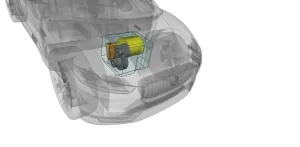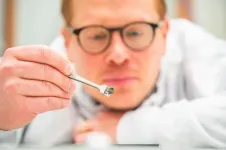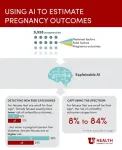(Press-News.org) Key cells in the brain, neurons, form networks by exchanging signals, enabling the brain to learn and adapt at incredible speed. Researchers of the Delft University of Technology in The Netherlands (TU Delft) have developed a 3D-printed ‘brain-like environment’ where neurons grow similarly to a real brain. Using tiny nanopillars, they mimic the soft neural tissue and the brain extracellular matrix fibers. This model provides new insights into how neurons form networks, as well as a novel tool to understand in future how this process may change in neurological disorders such as Alzheimer’s, Parkinson’s disease, and autism spectrum disorders.
Neurons, like many cells in the body, respond to the stiffness and geometry of their surroundings. Traditional petri dishes are flat and rigid, unlike the soft, fibrous extra-cellular matrix environment of the brain. To resemble the geometric and mechanical properties of this environment, the team of associate professor Angelo Accardo designed nanopillar arrays using two-photon polymerization, a 3D laser-assisted printing technique with nanoscale precision.
These pillars, each of which thousand times thinner than a human hair, are arranged like tiny forests on a surface. By changing the width and height, or aspect ratio, of the pillars, the researchers tuned their effective shear modulus, a mechanical property sensed by cells when crawling on top of micro- or nano-structures' arrays. “This tricks the neurons into "thinking" that they are in a soft, brain-like environment, even though the nanopillars’ material itself is stiff. While bending under the crawling of neurons, the nanopillars not only simulate the softness of brain tissue but also provide a 3D nanometric structure that neurons can grab onto, much like the extra-cellular matrix nano-fibers in real brain tissue,” says Accardo. This influences how the neurons grow and connect with each other.
From random growth to ordered networks
To test the model, the researchers grew three different types of neuronal cells, derived either from mouse brain tissue or from human stem cells, on the nanopillars. In traditional flat petri dishes and 2D biomaterials, neurons grew in random directions. But on the 3D-printed nanopillar arrays, all three cell types grew in more organized patterns, forming networks at specific angles.
The study, published in Advanced Functional Materials and featured on its cover, also revealed new insights into neuronal growth cones. Accardo: “These hand-like structures guide the tips of growing neurons as they search for new connections. On flat surfaces, the growth cones spread out and remain relatively flat. But on the nanopillar arrays, the growth cones sent out long, finger-like projections, exploring their surroundings in all directions — not just along a flat plane but also in the 3D space, resembling what happens in a real brain environment.”
“In addition, we found that the environment created by the nanopillars also seemed to encourage neurons to mature”, highlights George Flamourakis, first author of the study. Neural progenitor cells grown on the pillars showed higher levels of a marker of mature neurons, compared to those grown on flat surfaces. “This shows that the system not only influences the direction of growth but also promotes neuronal maturation.”
A tool for studying brain disorders
However, if softness is so important, why not just grow neurons on soft materials like gels? “The problem is that gel matrices, like collagen or Matrigel, typically suffer from batch-to-batch variability and do not feature rationally designed geometric features. The nanopillar arrays model offers the best of both worlds: it behaves like a soft environment with nanometric features, and holds extremely high reproducibility thanks to the resolution of two-photon polymerization,” explains Accardo.
By better replicating how neurons grow and connect, the developed model could offer new insights into the differences between healthy brain networks and those associated with neurological disorders, such as Alzheimer’s, Parkinson’s disease and autism spectrum disorders.
END
TU Delft develops 3D-printed brain-like environment that promotes neuron growth
Researchers develop nanostructures that guide neural networks growth and directionality
2025-01-30
ELSE PRESS RELEASES FROM THIS DATE:
E-mobility: TU Graz AI system accelerates the development of powertrains
2025-01-30
The development of vehicle components is a lengthy and therefore very costly process. Researchers at Graz University of Technology (TU Graz) have developed a method that can shorten the development phase of the powertrain of battery electric vehicles by several months. A team led by Martin Hofstetter from the Institute of Automotive Engineering is combining simulation models of components with evolutionary optimisation algorithms. This AI system automatically optimises the entire powertrain – from the power electronics to the electric machine through to the transmission – in line with the manufacturer’s technical requirements, taking ...
Better digital memories with the help of noble gases
2025-01-30
The electronics of the future can be made even smaller and more efficient by getting more memory cells to fit in less space. One way to achieve this is by adding the noble gas xenon when manufacturing digital memories. This has been demonstrated by researchers at Linköping University in a study published in Nature Communications. This technology enables a more even material coating even in small cavities.
Twenty-five years ago, a camera memory card could hold 64 megabytes of information. Today, the same physical ...
Smarter memory paves the way for EU independence in computer manufacturing
2025-01-30
New technology from Chalmers University of Technology and the University of Gothenburg, Sweden, is helping the EU establish its own competitive computer manufacturing industry. Researchers have developed components critical for optimising on-chip memory, a key factor in enhancing the performance of next-generation computers.
The research leader, Professor Per Stenström, along with colleagues, has discovered new ways to make cache memory work smarter. A cache is a local memory that temporarily stores frequently accessed data, improving a computer’s ...
Future of UK peatlands under threat due to climate change
2025-01-30
The UK’s peatlands face an uncertain future amid the escalating impacts of climate change.
Peatlands are critical ecosystems for carbon storage and biodiversity, containing more carbon than all the world's forests despite covering just 3% of the global land surface.
But new research reveals that vast areas of the UK’s peatlands, including the Flow Country UNESCO World Heritage Site, are likely to be unsuitable for peat accumulation by 2061–80 due to climate change.
The researchers urge for a shift in conservation strategies, with the ...
‘Sleep hygiene’: How FIFO workers can get a better night's sleep
2025-01-30
‘Sleep hygiene’: How FIFO workers can get a better night's sleep
Better sleep hygiene could see fly-in, fly-out (FIFO) mining shift workers get a better night’s sleep, new research from Edith Cowan University (ECU) has shown.
Sleep hygiene includes habits and sleep environment factors that can positively influence sleep, including a healthy diet, physical exercise and limited screen time. While these all seem obvious, the remote location of mine sites across Australia and the ...
AI-based pregnancy analysis discovers previously unknown warning signs for stillbirth and newborn complications
2025-01-30
###EMBARGOED BY BMC PREGNANCY AND CHILDBIRTH UNTIL 1AM GMT JAN 30 / 8PM ET JAN 29###
A new AI-based analysis of almost 10,000 pregnancies has discovered previously unidentified combinations of risk factors linked to serious negative pregnancy outcomes, including stillbirth.
The study also found that there may be up to a tenfold difference in risk for infants who are currently treated identically under clinical guidelines.
Nathan Blue, MD, the senior author on the study, says that the AI model the researchers generated helped identify a “really unexpected” combination of factors associated with higher risk, and that the model is an important step ...
Antidepressants reduce anxiety, but long-term impact remains unclear
2025-01-30
A new Cochrane review confirms that antidepressants effectively reduce symptoms of generalized anxiety disorder (GAD) under trial conditions, although there is limited data on long-term usage.
GAD affects millions of people worldwide and is characterized by excessive worry about everyday issues. Antidepressants, particularly selective serotonin reuptake inhibitors (SSRIs) and serotonin-norepinephrine reuptake inhibitors (SNRIs), are recognized treatments for GAD, recommended by many national bodies including the UK’s National Institute for Health and Care Excellence. However, misconceptions ...
Childhood trauma strongly linked to mental health problems in Brazilian adolescents, new study finds
2025-01-30
Childhood trauma can include witnessing death, experiencing severe injury, and physical or sexual violence.
Over 81% of Brazilian youth had experienced trauma by age 18.
Trauma was potentially responsible for a third of all mental health disorders by age 18.
A new study by a team of researchers from the UK and Brazil has revealed a strong connection between childhood trauma and the development of psychiatric disorders in adolescents living in low-and middle-income countries.
The research findings are based on the 2004 Pelotas Birth Cohort, Brazil, which has tracked more than 4,000 children born in Pelotas, a city in the southern ...
Researchers leverage large-scale data to uncover new insights into rare diseases and COVID-19
2025-01-30
An England-wide study of over 58 million people has identified eight rare diseases that carry significantly increased risks for COVID-19-related mortality in fully vaccinated individuals. This important research calls for better inclusion of rare diseases in public health strategies, including future pandemic planning, vaccination policies, and NHS service provision.
Historically rare diseases have been difficult to study and neglected in research, in part due to a lack of large-scale data. This means that people living with rare conditions often struggle to get the treatment and support they need. Additionally, rare disease patients were overlooked in public health ...
Fresh embryo transfer may be better for women with low chance of IVF success
2025-01-30
Fresh embryo transfer may be a better option than use of frozen embryos for women with a low chance of having a healthy baby by vitro fertilisation (IVF), suggests a trial from China published by The BMJ today.
The researchers say their findings do not support the routine use of the freeze-all strategy in women with low prognosis of IVF treatment success, which can be due to older age, low quantity or quality of eggs, or certain underlying conditions.
IVF has revolutionised infertility treatment and a strategy of freezing all suitable embryos before transfer (freeze-all strategy) is now a routine part of the treatment to help prevent ...
LAST 30 PRESS RELEASES:
Making lighter work of calculating fluid and heat flow
Normalizing blood sugar can halve heart attack risk
Lowering blood sugar cuts heart attack risk in people with prediabetes
Study links genetic variants to risk of blinding eye disease in premature infants
Non-opioid ‘pain sponge’ therapy halts cartilage degeneration and relieves chronic pain
AI can pick up cultural values by mimicking how kids learn
China’s ecological redlines offer fast track to 30 x 30 global conservation goal
Invisible indoor threats: emerging household contaminants and their growing risks to human health
Adding antibody treatment to chemo boosts outcomes for children with rare cancer
Germline pathogenic variants among women without a history of breast cancer
Tanning beds triple melanoma risk, potentially causing broad DNA damage
Unique bond identified as key to viral infection speed
Indoor tanning makes youthful skin much older on a genetic level
Mouse model sheds new light on the causes and potential solutions to human GI problems linked to muscular dystrophy
The Journal of Nuclear Medicine ahead-of-print tip sheet: December 12, 2025
Smarter tools for peering into the microscopic world
Applications open for funding to conduct research in the Kinsey Institute archives
Global measure underestimates the severity of food insecurity
Child survivors of critical illness are missing out on timely follow up care
Risk-based vs annual breast cancer screening / the WISDOM randomized clinical trial
University of Toronto launches Electric Vehicle Innovation Ontario to accelerate advanced EV technologies and build Canada’s innovation advantage
Early relapse predicts poor outcomes in aggressive blood cancer
American College of Lifestyle Medicine applauds two CMS models aligned with lifestyle medicine practice and reimbursement
Clinical trial finds cannabis use not a barrier to quitting nicotine vaping
Supplemental nutrition assistance program policies and food insecurity
Switching immune cells to “night mode” could limit damage after a heart attack, study suggests
URI-based Global RIghts Project report spotlights continued troubling trends in worldwide inhumane treatment
Neutrophils are less aggressive at night, explaining why nighttime heart attacks cause less damage than daytime events
Menopausal hormone therapy may not pose breast cancer risk for women with BRCA mutations
Mobile health tool may improve quality of life for adolescent and young adult breast cancer survivors
[Press-News.org] TU Delft develops 3D-printed brain-like environment that promotes neuron growthResearchers develop nanostructures that guide neural networks growth and directionality




